Abstract
The Sendai Framework for Disaster Risk Reduction emphasizes the need to rebuild better after a disaster to ensure that the at-risk communities can withstand a similar or stronger shock in the future. In the present work, the authors analyzed the reconstruction paths through a comparative analysis of the perspective of a community in Japan and another in Chile, and their respective local governments. While both countries are at risk to tsunamis, they follow different reconstruction philosophies. Data was gathered through key informant interviews of community members and local government officials, by adapting and modifying the Building Resilience to Adapt to Climate Extremes and Disasters (BRACED) 3As framework to a tsunami scenario. The 3As represent anticipatory, adaptive, and absorptive capacities as well as transformative capacities and respondents were asked to rate this according to their perspectives. It was found that while both communities perceive that much is to be done in recovery, Kirikiri has a more holistic and similar perspective of the recovery with their government officials as compared to Dichato. This shows that community reconstruction and recovery from a disaster requires a holistic participation and understanding.
1. Introduction
On 27 February 2010, a Mw. 8.8 earthquake struck the coast of central Chile, causing widespread damage and triggering a tsunami. The epicenter of the earthquake was located 60 km (37 miles) north of Concepcion, Chile’s second most populous city. This earthquake was Chile’s second largest ever recorded, following the Great Chilean Valdivia Earthquake of 1960. This 2010 disaster resulted in an estimated 30 billion US$ worth of damages (UNEP 2011) and claimed 525 lives, with 25 missing and thousands left homeless.
A year after, on 11 March 2011, a Mw. 9.1, undersea megathrust earthquake struck off the Pacific coast of northern Japan. This event was the largest recorded earthquake to have hit Japan, with the tsunami waves that were subsequently generated having run-up heights measuring between 10 and 40 m along the Tohoku coastline [1]. The Japanese National Police Agency reports confirmed 15,894 deaths and 2561 people still missing [2]. The Japanese Cabinet Office in 2011 estimated that US$ 169 billion worth of assets were lost, equivalent to approximately 3% of the country’s gross domestic product [3]. The damages incurred makes it one of the costliest disasters in recent history.
These disasters were followed by post-disaster phases of rehabilitation and reconstruction. The rehabilitation phase focuses on infrastructure repair and the restoration of facilities, with reconstruction representing the long-term efforts to revive livelihood, economy, industry, environment, and culture and traditions [4,5]. These two disasters occurred on the Pacific Ring of Fire, wherein most of the earthquakes in the world occur. This makes both countries no stranger to such events. However, the reconstruction philosophies differ between these two countries.
The Japanese approach is based on a conceptual strategy that distinguishes between Level 1 and Level 2 tsunamis (the 2011 Tohoku event was classified as Level 2). The concept of “build-back-better,” although with its own challenges [6], was taken to new heights in Japan, where large scale infrastructure was constructed to protect the affected communities from a similar event in the future [5]. Furthermore, while the aftermath of disaster can present a “sustainable socio-economic development” opportunity [7,8,9,10], there are still questions as to whether such an approach is sustainable and can support the socio-economic development of local communities [5].
Meanwhile, reconstruction philosophy in Chile focuses primarily on the recovery and restoration of physical structures within the coastal communities affected. This process is usually driven by the national government and is based on a cost-benefit analysis. This top-down strategy is double-edged as while it can help governments save money, it may lead to little or to no community consultation, as it is not seen as a requirement. This leaves communities without a clear understanding of the process and their involvement [11]
Mileti et al discusses that when socio-economic vulnerability is not addressed, the effect of disasters can be exacerbated [12]. In this case, the Chilean post-tsunami reconstruction lacked consideration in addressing socio-economic vulnerability due to minimal community involvement. The reconstruction strategy did not consider disaster prevention and is designed to allow residents to have more time to evacuate rather than to stop a tsunami. Nevertheless, some of the infrastructure that was built following the tsunami can serve a variety of functions and has arguably improved the aesthetics and lives of coastal residents [13].
The approaches of each country clearly bring their own challenges and opportunities. Many questions arise, such as what can be improved, were the strategies employed successful, and if so, can they be replicated? The Sendai Framework for Disaster Risk Reduction 2015-2030 emphasizes the concept of Build Back Better and highlights the opportunity that effective disaster reconstruction should lead towards enhanced disaster risk reduction [14].
The authors thus set out to investigate these questions and analyse the outcomes and challenges of the reconstruction process in each of these two countries using a comparative analysis, which focuses on two specific communities that shared several common physical and socio-economical features: Kirikiri, a distinct part of Otsuchi Town in Iwate Prefecture (Japan), and Dichato in the Bio Bio Region (Chile).
Despite such similarities, the present work does have some limitations regarding the scale of the disaster. The damage cost of the 2010 Chile tsunami is 30 billion USD [13] and the 2011 Tohoku tsunami is 300 billion USD [15]. Nevertheless, conducting such an exercise can highlight some preliminary differences between the communities and lessons that could be learnt for other disasters.
The team conducted the analysis by modifying the UK’s Department for Foreign and International Development (DFID) 3As Model for Building Resilience and Adaptation to Climate Extremes and Disasters [16]. Given that this framework was designed for climate extremes and related disasters, it was necessary to adopt it to the case of tsunamis, which constitutes part of the originality of the present research. The framework thus considers the anticipatory, adaptive, absorptive, and transformative capacities of each of the two communities, attempting to compare the traits and issues in each country, and draw lessons regarding reconstruction. To do so, the authors conducted both semi-structured interviews and field observations with local members of the community and a variety of local members of the administration. Finally, a comparative analysis of the responses was performed to understand the capacity of each community.
2. Framework
The United Nations International Strategy for Disaster Reduction (2009) discusses the concept of resilience as “the ability of a system, community, or society exposed to hazards to resist, absorb, accommodate, adapt to, transform, and recover from the effects of a hazard in a timely and efficient manner, including through the preservation and restoration of its essential basic structures and functions through risk management” [17].
Following this definition, the authors set out to develop an original methodology to analyse the recovery strategies in the target countries, adopting the framework of the United Kingdom’s Department for International Development’s Building Resilience to Adapt to Climate Extremes and Disasters (BRACED) 3A model. This strategy was part of the official development assistance of the Government of the United Kingdom for developing countries to address both disaster and climate extremes [18]. This approach is heavily based on disaster risk and climate change management, looking into climate change as a risk driver of disasters. The two case studies that were analysed in the present research have little to no climate change influences in them, given that tsunami hazards have a completely different driver from climate change enhanced hazards. Thus, it was necessary to rethink these indicators and adapt them to incorporate geological disasters, such as earthquakes and tsunamis. Therefore, the BRACED 3As model was adapted to incorporate shock events that can happen with little to no warning and how communities will be able to address them.
The BRACED 3As views resilience as having four capacities: Anticipatory, adaptive, absorptive, and transformative. While the names of the each of the capacities was maintained from the original framework, their definition and nuance have been changed to make them more relevant to the study of tsunami disaster risk management and reconstruction.
- Anticipatory capacity is the ability of social systems to anticipate and reduce the consequences of extreme events through preparedness and planning. Anticipatory capacity is seen as a proactive action before a foreseen event, in order to avoid upheaval (either by avoiding or reducing exposure or by minimizing vulnerability to specific hazards) [16]. In the present research, the focus of this capacity is on preventative measures, such as dikes, seawalls, and other infrastructure.
- Adaptive capacity is the ability of social systems to adapt to multiple, long-term, and future risks, and to learn and adjust after a disaster. It is the capacity to take deliberate and planned decisions to achieve a desired state, even when conditions have changed or are about to change [16]. As this paper addresses a shock event, this concept is focused on hazard specific disaster preparedness, particularly against tsunamis.
- Absorptive capacity refers to the ability of social systems, using available skills and resources, to face and manage adverse conditions, emergencies, or disasters [16].
- Transformative capacity can describe an unintended change, but generally refers to deliberate attempts to engineer the changes required to achieve a desired goal or outcome [16].
3. Methodology
Data collection involved field surveys and many key informant interviews. The aim of the field observations was to better understand the reconstruction efforts that have been attempted at each location, which were then contrasted and complemented with the results of the key informant interviews, to provide a holistic perspective on the achievements and lessons that can be learnt from the reconstruction process. Two case study sites were considered, both small communities which are relatively far away from the nearest big urban centre.
3.1. Description of Study Sites
The present research was centred on the towns of Dichato, Concepcion, Chile, and Kirikiri, Otsuchi, Japan. Table 1 shows a comparison of the study sites in terms of tsunami inundation height, casualties, affected population, and infrastructure destroyed, based on the available literature. Other than the tsunami height, the number of casualties and affected population were similar in proportion. The two sites were chosen were thus chosen because of their similarity, in order to highlight community cohesion and participation in disaster recovery from two different socio-cultural perspectives.

Table 1.
Comparison of study sites.
The case study area in Chile is located within the boundaries of the Greater Concepcion area, which belongs to the Bio Bio Region; one of the main regions affected by the 2010 tsunami [23]. Historically, Concepcion has been highly prone to earthquakes and tsunamis [24,25]. Hence, some of the informants have already had first-hand experience or at least heard the stories about tsunami events prior to the 2010 Chilean tsunami. Dichato, which is a fishing community that is frequented by tourists during summer time, was selected as it was particularly badly damaged by the tsunami.
Similarly, the village of Kirikiri was selected as the Japanese case study, as it experienced the 2011 Tohoku Earthquake Tsunami [5]. Kirikiri is part of the large administrative area of Otsuchi town, in Iwate prefecture, and is an old small fishing community. However, Kirikiri beach is also a famous tourist destination among local tourists, and thus comparable to the case of Dichato in Chile. Post-tsunami reconstruction strategies have been planned separately for different communities within Otsuchi, according to the preferences of each community, and there are clearly differences between them.
In terms of geographic location (Figure 1 and Figure 2), both Kirikiri and Dichato are separated from the main administrative town area. (Kirikiri is connected to Otsuchi downtown area through a tunnel highway, and Dichato is also comparatively far from the Greater Concepcion area). This separation has clearly influenced reconstruction at the community level, as will be detailed later.
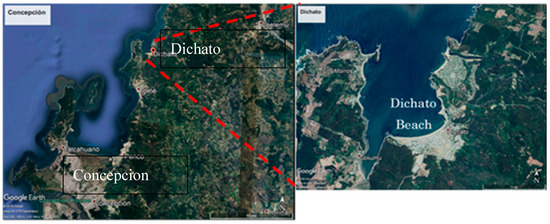
Figure 1.
The Bay of Concepcion in Chile, showing the location of Dichato.
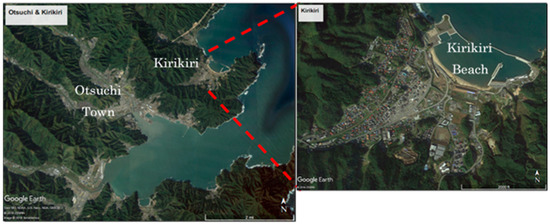
Figure 2.
Otsuchi Bay in Japan, showing the location of Kirikiri.
3.2. Semi-Structured Interviews
Semi-structured interviews were conducted by the authors in both case study sites. The interviews in Dichato were conducted between the 6–8 August 2017 while the data gathering in Kirikiri was between the 28 August 2017 and 4 September 2017. While the two tsunami events were nearly one year apart, the interviews were conducted more than half a decade after the disaster. This allowed the informants to possess a holistic picture of the processes they underwent during the different phases of disaster recovery. The key informants all represented important community members or administration officials (either civil servant or elected administration officials) in the study areas and their surrounding (for the case of Chile they were based in Penco, Tumbes, and Talcahuano and Concepcion, and for the case of Kirikiri, some were interviewed in Otsuchi, as Kirikiri is administered from it). A total of 19 (7 + 12) interviews were carried out in the language of each of the countries (the authors included native speakers of both Spanish and Japanese), see Figure 3. Table 2 provides details of the occupation and classification (either community members or the administration) for each of the key informant interviews.
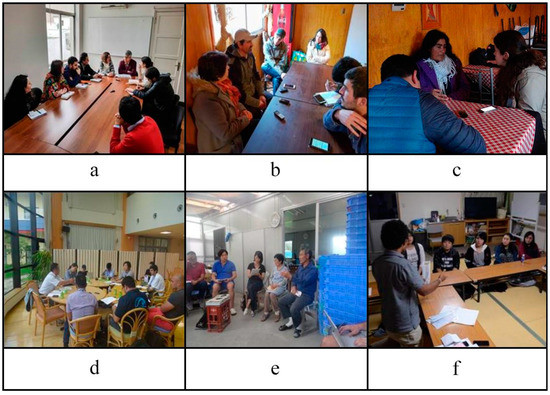
Figure 3.
Key informant interviews were carried out in Chile [Photo (a–c)] and Japan [Photo (d–f)], involving (a) an architect working at the Ministry of Urban Planning, (b) a representative from the Local Fishery Association of the Bio Bio Region, (c) a representative from the Local Women’s association of the Bio Bio Region, (d) a member of Otsuchi town council, (e) the director of the women’s group of Kirikiri fishery and fishermen, and (f) junior and high school girls in Otsuchi city.

Table 2.
Details of key informant interviews for both Chile and Japan.
The semi-structured interviews consisted of a total of 20 main questions, separated into four main categories, each of which tried to gauge the level of development of each of the four capacities highlighted earlier (Anticipatory, adaptive, absorptive, and transformative capacity). Respondents were also asked to rate these four capacities for their respective communities, on a Likert scale of 1 to 5. The Likert-scale answers were then averaged by interviewee type (i.e., community or administration), and by the total number of interviewees for each country. Table 3 provides the complete list of the main questions that were asked during these interviews. These questions were often followed by other clarification questions, though these varied from case to case, depending on the answered provided by the interviewee.

Table 3.
List of the questions asked during the key informant interviews.
3.3. Field Observations
The authors conducted field observations in both communities following each of the disasters [1,2], and continued to visit these communities throughout the reconstruction period [26]. For the purpose of writing the present paper, the coastline of these communities was surveyed once more; the notes and photographic evidence collected appear in the results and discussion.
4. Results
As explained earlier, the key informant interviewees in each location were divided into two groups, depending on whether they were members of the community or part of the administration (i.e., civil servants, majors, etc). The Likert-scale answers were then analysed by obtaining the averages for each group, which provided a qualitative numerical measure for a scale for the interviews. The rest of the answers were used to validate the reasons behind the informant’s perception. The averages obtained are thus representative of the perception of informants to the various capacities rather than a clear quantitative scale.
4.1. Chile
Figure 4 shows that community informants in Chile scored highly in the anticipatory and adaptive capacity. Essentially, in their responses, the members of the community all agreed that they felt well prepared to face a tsunami disaster (anticipatory capacity), as they still remembered stories that their elders recounted about these events, and that they had been educated by them on how to act in these extreme situations. The adaptive capacity also scored highly, as they attempted to improve during the reconstruction process. Despite the high score, respondents still felt that there was a lack of services provided after the 2010 disaster (including medical support, basic services, water supply, temporary houses, or sanitary conditions among others). Some complained that they were still experiencing some of these types of problems.
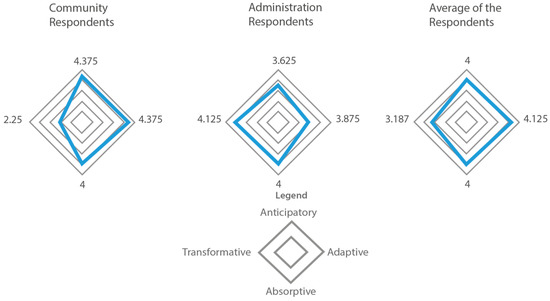
Figure 4.
Average of the capacities in Chile (on a Likert scale of 1–5 with 5 representing the highest score).
In contrast, the municipality interviewees rated the anticipatory and adaptive capacity as the lowest, and transformative and absorptive capacity much higher. They believed that if the same disaster happens again, the recovery capacity will be higher and that communities will suffer less damage, given the efforts made into the organization of drills, disaster education, a protocol on evacuations, and the implementation of official alarming systems.
The average of all (community and municipality) interviewees show that the highest average score is that for the adaptive capacity (4.125). With this, there is an overall feeling that the community is better prepared for the next disaster, given that the idea that they must flee the shoreline is well established in the collective memory (thanks to stories from elders and the recent memory about the event), and also due to the new countermeasures that had been implemented.
4.2. Tohoku
Figure 5 shows the average scores for the four different capacities reported by key informant interviewees in Japan, indicating how many felt that Kirikiri was not well prepared to face a tsunami disaster on the scale of 3.11 (lower anticipatory capacity, particularly reported by community respondents). However, they acknowledged that Kirikiri dealt with the situation swiftly and effectively (higher absorptive capacity). Overall, the lowest scores were given to transformative capacity, with both community respondents and members of the administration reporting this as the lowest of the four capacities.

Figure 5.
Average of the capacities in Japan ((on a Likert scale of 1–5, with 5 representing the highest score).
5. Discussion
5.1. Differences in Reconstruction Philosophy
There are significant differences in the reconstruction philosophy between Japan and Chile, as highlighted by those interviewed as part of the present work. These differences will be discussed in detail in the following subsections.
5.1.1. Reconstruction Philosophy in Japan
Following the 2011 event, the tsunami reconstruction philosophy in Japan changed substantially, as the idea that coastal defences could always protect communities was abandoned. Instead, the government accepted that a two-level defence approach strategy was needed, and this section will explain the consequences of this for reconstruction in Kirikiri. Also, the reconstruction emphasized the need to establish multiple layers of defence, in order to improve the overall safety and resilience of coastal settlements.
Differentiation of Defence Protection Countermeasures: Concept of Level I and II Tsunamis
Conventional tsunami mitigation philosophy in Japan prior to the 2011 event involved the combination of structures (hard) and non-structure (soft) based countermeasures. Seawalls and dykes were broadly classified as hard countermeasures, with their heights being determined by the worst tsunami event to have affected a given area in recent times. Soft types of countermeasures were well established, and involved evacuation training, drills, and tsunami shelters. However, many of the evacuation shelters were not sufficiently high [2] and there were other inconsistencies in evacuation in various locations.
In the aftermath of the 2011 Tohoku Earthquake Tsunami, the Japanese Society of Coastal Engineers issues new guidelines regarding a two-level tsunami concept to help guide reconstruction philosophy [27]:
-Level 1 Events (Tsunami Protection level). Would represent events with a return period of several decades to around 100 years. The height of seawalls would be designed with this level in mind, and the philosophy would be that they should be able to protect houses and infrastructure against the more frequent events. Also, such structures would play a role in helping residents evacuate.
-Level 2 Events (Tsunami Evacuation level). These would be rarer events, typically taking place at intervals of between every few hundred and a few thousand years apart. Evacuation systems should always be designed to protect the lives of residents against such events.
Regardless of the level of a given event, all coastal residents would be instructed to evacuate in the case of a tsunami, as they should never rely on coastal defences to protect their lives.
Multi-Layer Safety
In Japan, following each major historic tsunami event there has been a drive to increase disaster preparedness through the construction of defence structures and the relocation of communities away from danger zones [28]. After the 2011 event, these countermeasures have started to be framed around the concept of having multiple layers of safety. Multi-layer safety is a concept in flood risk management that introduces the integration of flood risk probability-reducing measures and loss-mitigating measures in a flood protection system [27,29,30,31]. The role of the former is to prevent inundation, whereas the latter are meant to be effective when the first line of flood defences fails, and inundation takes place. For the case of Tohoku, three different safety layers can be distinguished (see Figure 6),

Figure 6.
Multi-layer safety in a coastal flood protection system [32]. Reprinted from Exposing Underlying Risk: Disaster Risk Awareness in Informal Coastal Settlements with Low Disaster Threats (Master’s Thesis). By V.P.B. Valenzuela, 2018, The University of Tokyo, Tokyo, Japan. Copyright 2018 by Ven Paolo Bruno Valenzuela. Reprinted with Permission.
- Layer 1 (Prevention), including breakwaters, tsunami walls, or dykes that are aimed at blocking the advance of the tsunami wave.
- Layer 2 (Spatial Solutions), which is essentially the use of spatial planning and adaption of buildings to decrease losses if a flood does occur. Examples of Layer 2 measures include placing important social infrastructure buildings on higher grounds and the flood proofing of high buildings. It includes community planning that provides a safe environment, transportation networks, shelters, and land use planning
- Layer 3 (Emergency Management), which includes organizational preparation for floods, such as disaster plans, risk maps, early-warning systems, evacuation, and medical help. The focus of Layer 3 measures is to reduce the risks to human life. One of the key components of an effective Layer 3 is a rapid evacuation plan.
Application of Level I-Level lI Tsunami and Multi-Layer Safety Concepts to Kirikiri
The new Level I and II and multi-layer safety philosophy were implemented in the reconstruction of Kirikiri (they were implemented throughout the Sanriku coastline in the areas affected by the tsunami in Japan). The crown level of the seawalls was thus determined according to computer simulations to be Tokyo Peil (T.P.) +12.8 m (see Figure 7 and Figure 8), and all residential areas were elevated to a level of T.P. +12.0 m (which, for some parts of the village, involved raising the land by ~10m, see Figure 9). All this was done without conducting any cost-benefit analysis. The cost of construction was supported by the national government, though the future cost of maintenance will be supported by the prefectural government and the city itself.

Figure 7.
Diagrammatic representation of multi-layer safety interventions at Kirikiri.
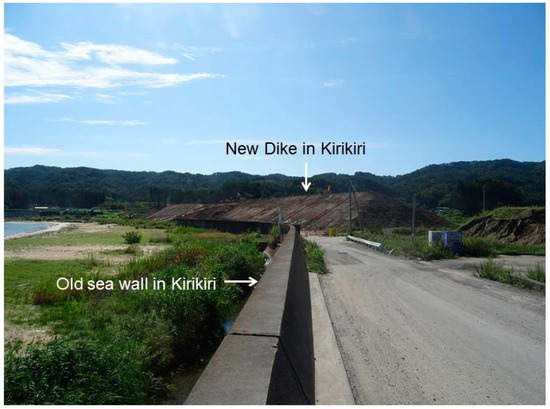
Figure 8.
The new dyke in Kirikiri was rebuilt to a higher level.
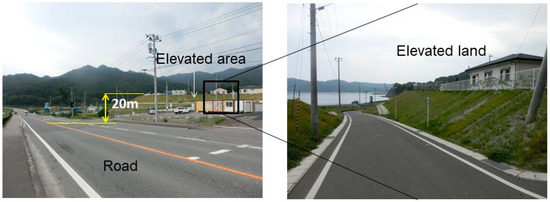
Figure 9.
Significant parts of Kirikiri were elevated, as part of the multi-layer safety defence. Picture shows houses constructed on elevated land.
Relocation is still a major concern among Kirikiri residents. Access to fishing, which is the main livelihood, is not a major issue, but their sense of ownership and belongingness to land delayed the relocation process. Another concern is that the relocation of some of the housing to nearby hilly areas has created new risks, such as landslides. The older generation is reticent to relocate, though the younger generations are much warmer about such ideas.
The decision to raise the land or relocate to higher ground as a means of tsunami protection is also imposed to the affected communities along the Sanriku Coast, including Kirikiri. Perception of the people interviewed to this strategy is mixed. Some of the informants’ view that it is unnecessary and cannot overcome soft measures, such as proper and timely emergency management. On the other hand, some view this as an important additional layer of protection–one that can protect them from moderately sized tsunamis and one that can buy time when a Level II tsunami does appear. However, such a measure was imposed, particularly when the recovery plan was presented and discussed with them. This led to several delays in the recovery planning process, but, ultimately, land was raised. This imposition of an action represents a common feature in Japanese society—that while there is discussion amongst the community, those who are in a higher authority would have more leverage in what action to take. In this case, the community must compromise with the demands of the national government.
5.1.2. Reconstruction Philosophy in Chile
The reconstruction process in Chile focused on repairing and improving infrastructure, leaving aside the reconstruction of the social environment. The government attempted to minimize the costs of reconstruction, and mostly emphasized the recovery of critical infrastructure. Essentially, there appears to be a disconnect between the government at almost all levels and the communities, with the relationship between them being almost vertical. In places like Dichato, people were not well informed about the reconstruction process. This lack of knowledge appears to stem partly from the lack of interest of residents in public policies, as well as a lack of rapprochement and involvement with the population by the central government. The central government prepares and presents reconstruction plans, without prior consultation with residents. This leads to emotions of rejection and unhappiness regarding the government plans, and in some cases, the feeling that they have been deceived by the government.
In contrast to the case of Japan, the countermeasures that were implemented following the event do not constitute a comprehensive multi-layer safety system. A new sea wall along the coastline constitutes some sort of layer 1 countermeasure (see Figure 10), though this is not high enough to stop significant tsunami events (such as the one that took place in 2010). A new coastal forest is an example of layer 2 (see Figure 11), though the designers agree that it is not long enough to stop a tsunami, such as that of 2010. Thus, while both interventions might mitigate some of the damage of future events, the focus is still on evacuation. Improved evacuation routes and signing are in place, which would assist the population in the case of a future tsunami (layer 3).
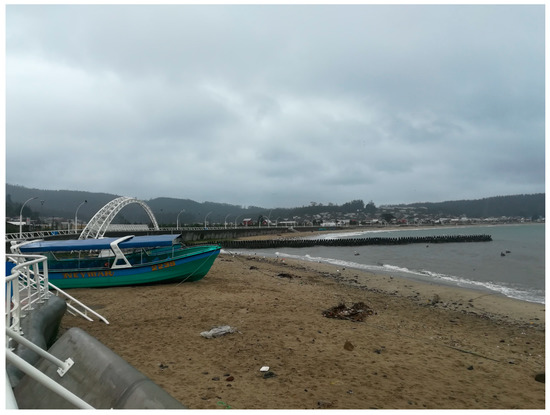
Figure 10.
Layer 1 measures in Dichato. Seawall at the end of the beach.
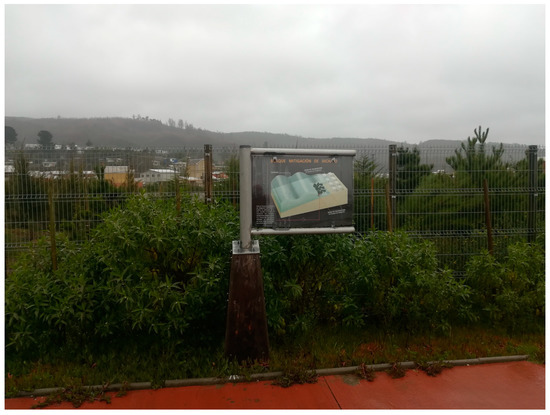
Figure 11.
Layer 2 measures in Dichato, tsunami protection forest.
5.1.3. Summary of Reconstruction Philosophy
Table 4 provides a comparative summary of the differences in the reconstruction philosophy between Japan and Chile. Essentially, while Japan has formalised their reconstruction strategies by dividing the types of countermeasures employed into return period levels (that do not consider cost/benefit assessments), in Chile, interventions are merely focusing on attempting to reduce the overall damage of any one given event. Higher order events are not considered at all, and evacuation should always be towards the hilly areas that surround the coastline. Such differences arise from budget limitations, though in the future, it will be necessary for Chile to move into more formalised types of tsunami reconstruction strategies that take into consideration probabilistic hazard return periods.

Table 4.
Comparative summary of defence strategies against tsunamis in Japan and Chile.
5.2. Differences in Resilience Capacities
Both communities perceived themselves as having a high resilience capacity. The most significant difference between them is the community respondents in Chile rated their transformative capacity as relatively low, and this represents a significant finding in the present study. Although key informants in Kirikiri did not rate this capacity as especially high, they noted how the area could recover without much external support, and that they were able to come up with their own reconstruction strategy (using funds available from the national government). Reasons for this include the fact that Kirikiri has been there for a long time and that it has a high level of coastal cohesion, as in former times travelling along the mountainous terrain in Iwate coast was difficult, which has shaped the local character [33].
Nevertheless, some of the key informants have concerns about the reconstruction strategy that was eventually implemented:
“10 Billion JPY came for the reconstruction from the national Government. Everyone tried to utilize all the money. But regular maintenance costs should be paid by the locals later. Community awareness of their financial capacities is still unknown” (Interview with a member of the Otsuchi town council, 29 August 2017).
“The voices of the people who lived in mountains were not listened to in the reconstruction process. The disaster recovery meetings were conducted to promote the major decision makers’ own plans, regardless of other people’s ideas” (Interview with a local Buddhist monk, 1 September 2017).
In comparison, the community perspective of Dichato’s recovery is low due to a difference in recovery planning priorities between them and the government. The interviews stated that while there was participatory planning involved, this was more of letting the community know what the recovery effort will be rather than how they want it to be. Businesses in Dichato stated that they did not receive funding for rebuilding or that the support provided to them was not enough. This is in contrast to what the government representatives state wherein businesses were recompensed for damages and that the current economy is now better than before.
6. Conclusions
There are no standard tsunami mitigation measures that can be applied throughout the world. Instead, countermeasures should depend on the place and culture where they are implemented. It is also important to verify whether these strategies are effective or not to reduce risks. For the case of Dichato, the countermeasures did not significantly reduce risks, while the resilience of Kirikiri was greatly enhanced through the adoption of a multi-layer safety strategy. Such a difference in reconstruction strategies appears to arise through the fact that the Japanese government has clearly formulated a post-tsunami rebuilding strategy that does not consider any cost/benefit analysis other than the distinction between Level I and Level II tsunamis. Chile, on the other hand, has not formulated any clear reconstruction strategies, with any measures being implemented undergoing a cost/benefit analysis, and probably only reducing the consequences of the more frequent events (rather than completely stopping them).
In terms of resilience capacities, social cohesion between communities and local governments reflects a holistic perspective in their role and responsibilities in building back better. While the averages of scores in how they view the recovery process is similar, the gap between the community perspective and government perspective is more evident in Dichato. This is reflected in different interpretations in how the recovery process should have gone and what the other should have done. While, in Kirikiri, the perspective is more introspective of the process, asking themselves what they could have done better. Thus, the comments raised by both villagers and leaders were similar. Social cohesion is therefore vital in any recovery process as this allows collaboration and cooperation in the planning towards resilience.
To ensure that the concept of “Build Back Better”, as stated in the Sendai Framework can be achieved, there is a need to develop a disaster recovery strategy or philosophy. This guides the recovery of communities to ensure inclusive and sustainable development despite the impact of a major disaster. The lessons from Kirikiri and Dichato show that while there is a fair share of challenges on participation, if there is a philosophy in which the reconstruction is centred on, then building back better can be achieved.
Author Contributions
Conceptualization, V.P.V.; Formal analysis, V.P.V., R.S.M.S., A.H.T.S.K., F.N., G.C.P.C., R.N.C., and M.Q.; Investigation, V.P.V., R.S.M.S., A.H.T.S.K., F.N., G.C.P.C., R.N.C., M.Q., R.Y., and M.E.; Methodology, V.P.V., A.H.T.S.K., and F.N.; Project administration, R.S.M.S, I.I., and O.M.; Supervision, R.A., O.M., and M.E.; Validation, V.P.V., F.N, and R.Y.; Writing—original draft, V.P.V., R.S.M.S., A.H.T.S.K., F.N., R.N.C., and M.E.; Writing—review & editing, V.P.V., R.S.M.S., R.A., and M.E.
Funding
This research would not have been possible without funding from SEELA (Science and Engineering Exchange Program with Latin America), an academic exchange program by the Re-Inventing Japan Project funded by the Ministry of Education, Culture, Sports, Science and Technology of Japan. Also, this Ministry also funds the Graduate Program on Sustainability Science, Global Leadership Initiative (GPSS-GLI), whose core funding was also used in this project. Finally, a part of the present work performed as a part of activities of Research Institute of Sustainable Future Society, Waseda Research Institute for Science and Engineering, Waseda University.
Acknowledgments
This research team would like to acknowledge the assistance of Mio Kamitani and the staff of Oraga Otsuchi Yume Hiroba in coordinating with local counterparts for the field work in Kirikiri and Otsuchi. Also, to Nick Iliopoulos who aided the research team during their field work in Chile.
Conflicts of Interest
The authors declare no conflict of interest. The funders had no role in the design of the study; in the collection, analyses, or interpretation of data; in the writing of the manuscript, or in the decision to publish the results.
References
- Mori, N.; Takahashi, T.; The 2011 Tohoku Earthquake Tsunami Joint Survey Group. Nationwide post event survey and analysis of the 2011 Tohoku Earthquake Tsunami. Coast. Eng. J. 2012, 54, 1250001. [Google Scholar] [CrossRef]
- Mikami, T.; Shibayama, T.; Esteban, M.; Matsumaru, R. Field survey of the 2011 Tohoku Earthquake and tsunami in Miyagi and Fukushima Prefectures. Coast. Eng. J. 2012, 54, 1250011. [Google Scholar] [CrossRef]
- Ranghieri, F.; Ishiwatari, M. Learning from Megadisasters: Lessons from the Great East Japan Earthquake; World Bank Publications: Washington, DC, USA, 2014; Available online: https://openknowledge.worldbank.org/bitstream/handle/10986/18864/9781464801532.pdf?sequence=1 (accessed on 20 November 2017).
- Matsumaru, R. Reconstruction from the Indian Ocean tsunami disaster: Case study of Indonesia and Sri Lanka and the philosophy of “Build back better”. In Handbook of Coastal Disaster Mitigation for Engineers and Planners; Butterworth-Heinemann: Oxford, UK, 2015; ISBN 9780128012703. [Google Scholar]
- Esteban, M.; Onuki, M.; Ikeda, I.; Akiyama, T. Reconstruction following the 2011 Tohoku Earthquake Tsunami: Case study of Otsuchi Town in Iwate Prefecture, Japan. In Handbook of Coastal Disaster Mitigation for Engineers and Planners; Esteban, M., Takagi, H., Shibayama, T., Eds.; Butterworth-Heinemann (Elsevier): Oxford, UK, 2015. [Google Scholar]
- Ong, J.M.; Jamero, M.L.; Esteban, M.; Honda, R.; Onuki, M. Challenges in Build-Back-Better Housing Reconstruction Programs for coastal disaster management: Case of Tacloban City, Philippines. Coast. Eng. J. 2016, 58, 1640010. [Google Scholar] [CrossRef]
- Wisner, B.; Blaikie, P.; Cannon, T.; Davis, I. At Risk: Natural Hazards, Peoples Vulnerability and Disasters; Routledge: Abingdon-on-Thames, UK, 2004; ISBN 0415084768. [Google Scholar]
- Harrington, L.M.B. Vulnerability and Sustainability Concerns for the US High Plains. In Rural Change and Sustainability: Agriculture, the Environment, and Communities; Essex, S.J., Gilg, A.W., Yarwood, R.B., Smithers, J., Wilson, R., Eds.; CABI: Wallingford, UK, 2005; pp. 169–184. [Google Scholar]
- Asgary, A.; Badri, A.; Rafieian, M.; Hajinejad, A. Lost and Used Postdisaster Development Opportunities in Bam Earthquake and the Role of Stakeholders. Proc. Int. Conf. Student Compet. Post- Disaster Reconstr. Meet. Stakehold. Interes. 2006. [Google Scholar]
- Palliyaguru, R.; Amaratunga, D. Linking Reconstruction to Sustainable Socio-Economic Development. In Post-Disaster Reconstruction of the Built Environment: Rebuilding for Resilience; Wiley-Blackwell: Hoboken, NJ, USA, 2011; ISBN 9781444333565. [Google Scholar]
- Rahman, M.S.; Kausel, T. Coastal Community Resilience to Tsunami: A Study on Planning Capacity and Social Capacity, Dichato, Chile. IOSR J. Hum. Soc. Sci. 2013, 12, 55–63. [Google Scholar] [CrossRef]
- Mileti, D.S.; Darlington, J.D.; Passarini, E.; Forest, B.C.; Myers, M. Toward an integration of natural hazards and sustainability. Environ. Prof. 1995, 17, 117–126. [Google Scholar]
- Khew, J.T.Y.; Pawel, M.; Dyah, F.; San Carlos, R.; Gu, J.; Esteban, M.; Aránguiz, R.; Akiyama, T. International Journal of Disaster Risk Reduction Assessment of social perception on the contribution of hard-infrastructure for tsunami mitigation to coastal community resilience after the 2010 tsunami: Greater Concepcion area, Chile. Int. J. Disaster Risk Reduct. 2015, 13, 324–333. [Google Scholar] [CrossRef]
- UN-General Assembly. Sendai Framework for Disaster Risk Reduction. In Proceedings of the Third United Nations World Conference on Disaster Risk Reduction, Sendai, Japan, 14–18 March 2015. [Google Scholar]
- Kazama, M.; Noda, T. Damage statistics (Summary of the 2011 off the Pacific Coast of Tohoku Earthquake damage). Soils Found. 2012, 52, 780–792. [Google Scholar] [CrossRef]
- Bahadur, A.V.; Peters, K.; Wilkinson, E.; Pichon, F.; Gray, K.; Tanner, T. The 3As: Tracking Resilience Across BRACED; BRACED Working Paper; Overseas Development Institute: London, UK, 2015. [Google Scholar]
- Terminology on Disaster Risk Reduction; UNISDR: Geneva, Switzerland, 2009; ISBN 978-600-6937-11-3.
- Villanueva, P.S.; Gould, C.; Pichon, F. Routes to Resilience BRACED Year 1 Synthesis. 2016. Available online: http://www.itad.com/wp-content/uploads/2016/12/Routes-to-resilience-BRACED-Year-1-SYNTHESIS-WEB.pdf (accessed on 20 November 2018).
- Fritz, H.M.; Petroff, C.M.; Catalán, P.A.; Cienfuegos, R.; Winckler, P.; Kalligeris, N.; Weiss, R.; Barrientos, S.E.; Menesesc, G.; Valderas-Bermejo, C.; et al. Field survey of the 27 February 2010 Chile Tsunami. Pure Appl. Geophys. 2011, 168, 1989–2010. [Google Scholar] [CrossRef]
- Martínez, C.; Rojas, O.; Villagra, P.; Aránguiz, R.; Sáez-Carrillo, K. Risk factors and perceived restoration in a town destroyed by the 2010 Chile tsunami. Nat. Hazards Earth Syst. Sci. 2017. [Google Scholar] [CrossRef]
- Nakai, Y. Reconstruction plan of otsuchi town, kamihei county, iwate prefecture. J. JSCE 2013, 1, 242–250. [Google Scholar] [CrossRef]
- Takezawa, S. The Aftermath of the 2011 East Japan Earthquake and Tsunami: Living among the Rubble; Lexington Books: Lanham, MD, USA, 2016. [Google Scholar]
- Mikami, T.; Shibayama, T.; Takewaka, S.; Esteban, M.; Ohira, K.; Aranguiz, R.; Villagran, M.; Ayala, A. field survey of tsunami disaster in Chile. J. Jpn. Soc. Civil Eng. Ser. B3 (Ocean Eng.) 2010, 67, 529–534. (In Japanese) [Google Scholar]
- Aránguiz, R.; Villagrán, M.; Esteban, M.; Shibayama, T. Tsunami resonance in the Bay of Concepcion, Chile. In Proceedings of the 34th International Conference on Coastal Engineering (ICCE), Seoul, Korea, 15–20 June 2014. [Google Scholar]
- Jaya, N.M.P.; Nagai, M.; Reyes, G.M.; Miura, F. Improved risk assessment of tsunami inundation based on geospatial and local knowledge for sustainable development. Int. J. Sustain. Future Hum. Secur. J.-SustaiN 2018, 6, 28–38. [Google Scholar]
- Esteban, M.; Takagi, H.; Mikami, T.; Bahbouh, L.; Becker, A.; Nurse, L.; Shibayama, T.; Nagdee, M. How to carry out bathymetric and elevation surveys on a tight budget: Basic surveying techniques for sustainability scientists. J.-SustaiN 2017, 5, 86–91. [Google Scholar] [CrossRef]
- Shibayama, T.; Esteban, M.; Nistor, I.; Takagi, H.; Danh Thao, N.; Matsumaru, R.; Mikami, T.; Aranguiz, R.; Jayaratne, R.; Ohira, K. Classification of tsunami and evacuation areas. J. Nat. Hazards 2013, 67, 365–386. [Google Scholar] [CrossRef]
- Esteban, M.; Tsimopoulou, V.; Mikami, T.; Yun, N.Y.; Suppasri, A.; Shibayama, T. Recent tsunami events and preparedness: Development of tsunami awareness in Indonesia, Chile and Japan. Int. J. Disaster Risk Reduct. 2013, 5, 84–97. [Google Scholar] [CrossRef]
- National Water Plan of the Netherlands. Available online: http://english.verkeerenwaterstaat.nl/english/Images/NWP%20english_tcm249-274704.pdf (accessed on 10 August 2012).
- Tsimopoulou, V.; Jonkman, S.N.; Kolen, B.; Maaskant, B.; Mori, N.; Yasuda, T. A multi-layer safety perspective on the tsunami disaster in Tohoku, Japan. In Proceedings of the Flood Risk 2012 Conference, Rotterdam, The Netherlands, 20–22 October 2012. [Google Scholar]
- Tsimopoulou, V.; Vrijling, J.K.; Kok, M.; Jonkman, S.N.; Stijnen, J.W. Economic implications of multi-layer safety projects for flood protection. In Proceedings of the ESREL Conference, Amsterdam, The Netherlands, 29 September–2 October 2013. [Google Scholar]
- Valenzuela, V.P.B. Exposing Underlying Risk: Disaster Risk Awareness in Informal Coastal Settlements with Low Disaster Threats. Master’s Thesis, University of Tokyo, Tokyo, Japan, 2018. [Google Scholar]
- Yoshihiro, K.; Burakura, T.; Minami, A. Support for making voluntary disaster prevention plans in disaster areas and developing disaster prevention town planning. J. Rural Plan. Acad. Soc. 2015, 33. [Google Scholar] [CrossRef]
© 2019 by the authors. Licensee MDPI, Basel, Switzerland. This article is an open access article distributed under the terms and conditions of the Creative Commons Attribution (CC BY) license (http://creativecommons.org/licenses/by/4.0/).